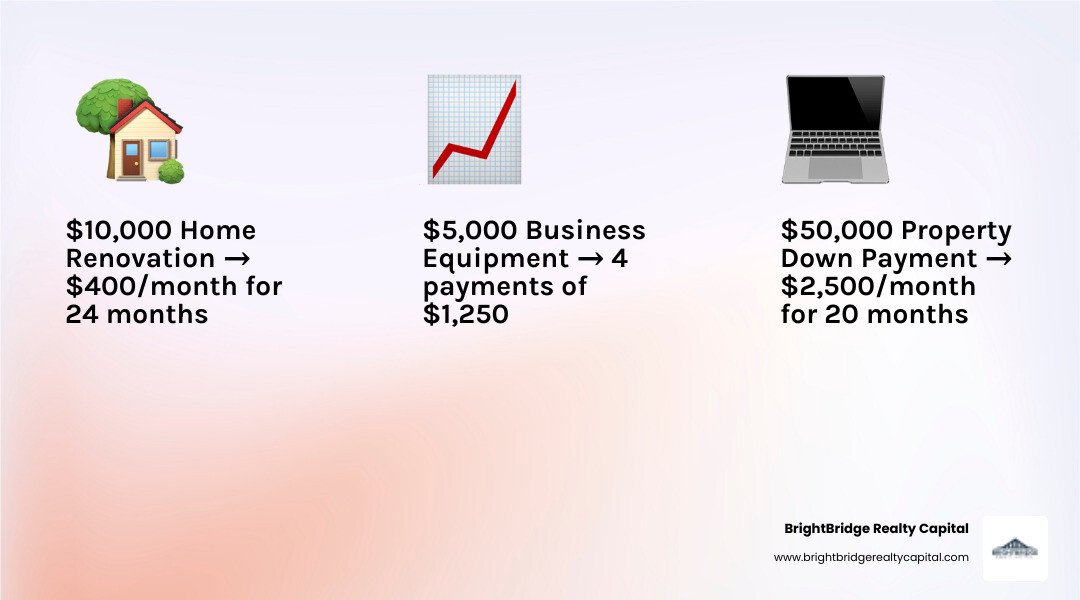Beyond the Bank: A Guide to Flexible Financing

Why Flexible Financing Options Are Changing How We Fund Our Goals
In a world that moves at the speed of a click, the traditional methods of securing funds often feel like relics from a bygone era. For decades, the path to financing—whether for a new car, a business venture, or a home—was a monolithic one, paved with rigid requirements, lengthy waiting periods, and mountains of paperwork. Flexible financing options have emerged not just as an alternative, but as a revolutionary force, fundamentally reshaping our access to capital and empowering individuals and businesses to achieve their goals with unprecedented speed and agility.
This financial evolution addresses a deep-seated and widespread frustration with the old guard of lending. Traditional banks, bound by legacy systems and conservative risk models, became synonymous with slow, opaque processes. Borrowers were often left in the dark for weeks, only to be met with a rejection based on criteria that didn't fully capture their financial reality. As one real estate investor recently shared with our team, \"The website interaction was smooth and straightforward, unlike traditional banks where you feel like you're submitting your application into a black hole.\" This sentiment captures the essence of the new paradigm. \"Smooth and straightforward\" means digital applications that take minutes, not hours; transparent terms laid out in plain language; and approval decisions powered by technology that can assess a borrower's profile holistically and almost instantly. Whether you're a consumer using a pay-in-4 plan to buy a new mattress, a small business leasing essential equipment, or an investor funding a property deal, flexible financing puts control, clarity, and confidence back into your hands.
This new landscape offers a diverse toolkit tailored to specific needs. Here’s a glimpse at the spectrum of what's now possible:
- For Everyday & Major Purchases: Consumers can now sidestep high-interest credit card debt for large purchases. Options like Buy Now, Pay Later (BNPL) plans break down costs into manageable, often interest-free installments, while point-of-sale loans provide longer-term financing for significant items like furniture or electronics, right at the moment of purchase.
- For Ambitious Businesses: Companies can acquire critical technology and equipment without depleting precious working capital. Equipment leasing, Hardware-as-a-Service (HaaS) subscriptions, and revenue-based financing allow businesses to align their expenses with their growth, preserving cash flow for hiring, marketing, and innovation.
- For Savvy Real Estate Investors: The fast-paced property market demands equally fast financing. Specialized products like fix-and-flip loans, bridge financing for transitional periods, and DSCR rental loans (which qualify based on property income, not personal income) provide the speed and leverage necessary to capitalize on opportunities that traditional lenders would miss.
I'm Daniel Lopez, a senior loan officer at BrightBridge Realty Capital. Over my career, I've had a front-row seat to this financial revolution, specifically within the dynamic world of real estate investment. I've helped hundreds of clients, from first-time flippers to seasoned portfolio managers, structure financing that transforms a good investment strategy into a great one. I've seen how a loan that closes in seven days instead of 45 can be the sole difference between winning a deal and watching it go to a competitor. My passion lies in demystifying these powerful financial tools and empowering investors to build wealth with confidence. This guide is designed to do just that.

Decoding the Spectrum of Flexible Financing
The true beauty of today's financing landscape is its incredible diversity and specificity. There is no longer a one-size-fits-all loan. Instead, a rich ecosystem of tailored solutions has emerged, designed to meet the unique demands of nearly every financial goal. Whether you're furnishing a new apartment, scaling your business with cutting-edge technology, or building a real estate empire, there are flexible financing options engineered for your exact situation.
For Personal & Retail Purchases: The Consumer Revolution
The days of automatically reaching for a high-APR credit card or draining a savings account for a large retail purchase are numbered. Modern consumer financing provides a smarter way to acquire goods and services without financial strain.

- Buy Now, Pay Later (BNPL): This is perhaps the most visible form of flexible financing. Services like Klarna, Afterpay, and Affirm have integrated seamlessly into online checkouts, allowing you to split a purchase into several equal, interest-free payments (typically four payments over six weeks). The psychological appeal is powerful: it lowers the upfront cost barrier, making purchases feel more manageable. You can get started with Klarna to explore its features. The business model often involves charging the merchant a small percentage of the transaction, making it a win-win for retailers who see higher conversion rates and average order values.
- Point-of-Sale (POS) Installment Loans: For larger ticket items, retailers like The Brick partner with financial technology companies like Flexiti to offer more structured installment loans. These are formal credit agreements, often branded as a store credit card like the FlexitiCard, but with fixed payment plans that can extend from 6 to 60 months. A key advantage of some of these products is that they may not charge retroactive interest if you miss a payment, unlike many traditional deferred-interest plans, though late fees will still apply.
- 0% Interest Promotional Financing: A classic offering from retailers like Best Buy (in partnership with lenders like Fairstone), these plans provide an interest-free period ranging from 3 to 18 months or more. This is essentially a free loan if, and only if, you pay the entire balance before the promotional period expires. The critical detail to understand is the concept of deferred interest. If even one dollar remains on the balance after the deadline, the lender can charge you interest retroactively on the entire original purchase amount from the date of purchase, often at a very high APR.
- Deferred Payment Plans: Options like Flexiti's \"Pay in a bit\" allow you to buy now but postpone the start of your payments for a set period (e.g., 90 days). This is an excellent tool for managing cash flow, especially when you're anticipating a future cash influx like a tax refund or work bonus, or need to align a large purchase with your pay cycle. You can explore these solutions at retailers like The Brick.
For Business & Technology Acquisition: Fueling Growth and Innovation
In the corporate world, maintaining a competitive edge requires continuous investment in technology and infrastructure. Flexible financing options for businesses are designed to facilitate this growth without compromising the lifeblood of the company: its cash flow.
- Hardware and Software Financing: Instead of a massive capital expenditure, companies can finance entire technology ecosystems. Lenders like Lenovo Financial Services bundle hardware, software, and ongoing services into a single, predictable monthly payment. Promotions like \"Save Now, Pay Later\" with 90-day deferrals allow businesses to deploy new tech and start generating ROI from it before the first payment is even due. See how it works at Lenovo Financial Services.
- Subscription Bundles & As-a-Service Models: The most significant shift in business financing is the move from capital expenses (CapEx) to operating expenses (OpEx). Instead of buying servers, businesses can use Hardware-as-a-Service (HaaS) models. This aligns IT costs directly with usage and growth, eliminates the burden of ownership and maintenance, and prevents technology from becoming obsolete.
- Cloud Marketplace and Platform Financing: Large tech ecosystems like AWS Marketplace offer financing programs that consolidate multiple third-party software purchases into a single payment plan. This simplifies procurement and billing, with financing costs often applied only to the services you actually consume. Similarly, providers like Oracle Financing create Custom Payment Solutions that are not just about managing costs but enabling strategic business change, with payment structures that can adapt to project milestones or seasonal revenue fluctuations.
- Revenue-Based Financing (RBF) & Merchant Cash Advances (MCA): For small businesses and startups, RBF and MCAs offer a powerful alternative to traditional loans. Instead of a fixed monthly payment, the business repays the financing as a percentage of its daily or weekly revenue. This means payments are lower during slow periods and higher during busy times, perfectly aligning with cash flow. While often more expensive than traditional debt, the speed and flexibility of these options can be invaluable for seizing growth opportunities.
For Real Estate Investors: The Speed to Succeed
Nowhere is the adage \"time is money\" more true than in real estate investing. Traditional bank loans, with their 30-60 day closing times, are simply too slow for the modern market. Specialized flexible financing options are not just a convenience; they are a strategic necessity. At BrightBridge Realty Capital, we live and breathe this reality every day.

- Fix-and-Flip Loans: These are short-term (typically 12-24 months), interest-only loans designed for purchasing and renovating a property. The key metric is the After Repair Value (ARV), and lenders can finance up to 70% of the ARV or 90% of the purchase and renovation costs. With rates from 9.50%, these loans allow investors to move with the speed of a cash buyer. Get more info about fix-and-flip services.
- Bridge Loans: This financing acts as a crucial \"bridge\" between two transactions. It provides short-term capital to acquire a new property before an existing one is sold, or to quickly close on a property that needs minor stabilization before it can qualify for long-term bank financing. It's the ultimate tool for timing-sensitive opportunities.
- DSCR Rental Loans: A game-changer for portfolio builders. Debt Service Coverage Ratio (DSCR) loans qualify the borrower based on the property's cash flow, not their personal W-2 income. The formula is simple: Net Operating Income / Total Debt Service. If the ratio is 1.25 or higher, the property's income is 25% more than its debt payments, making it a sound investment. With rates as low as 6.5% and leverage up to 80% LTV, these loans are perfect for self-employed investors or those with complex income streams. Learn more info about rental loan services.
- New Construction Financing: For building from the ground up, these loans are structured to fund a project in stages, or \"draws,\" as construction milestones are met. This protects both the lender and the borrower. With leverage up to 90% of the total project cost (Loan-to-Cost) and competitive rates starting at 9.99%, they make large-scale development projects accessible. We can provide more info about ground-up construction services.
- Hard Money Loans: When absolute speed is the number one priority, hard money loans are the answer. Provided by private lenders, these are asset-based loans focused almost entirely on the value of the property itself, with less emphasis on borrower credit. While the interest rates and fees are higher, they can often be funded in a matter of days, providing an unparalleled competitive advantage for securing in-demand properties.
As direct lenders, we control the entire process from application to funding. This eliminates the delays and uncertainties of dealing with intermediaries, allowing us to provide fast funding—often closing within a week. In today's competitive market, that speed is the ultimate advantage.
Understanding Your Flexible Financing Options
This section provides a comprehensive comparison between flexible financing and traditional methods, detailing the critical pros and cons that every borrower must consider before making a commitment.
How It Differs from Traditional Loans and Credit Cards
To truly appreciate the shift, it's essential to understand how flexible financing options diverge from the financial tools we've used for generations. The differences in speed, structure, purpose, and impact are profound.
| Factor | Flexible Financing (e.g., BNPL, POS loans, Private Lending) | Traditional Bank Loans (e.g., Personal, Mortgage) | Credit Cards |
|---|---|---|---|
| Approval Speed | Instant to a few days (e.g., Klarna, Flexiti, BrightBridge) | Days to weeks, sometimes months for mortgages | Often instant for online pre-approval, but receiving and using the card can take days |
| Loan Purpose | Highly specific: a single retail purchase, a tech upgrade, a real estate project | General purpose (personal loans) or specific large assets (car, home) | General purpose, revolving line of credit for any purchase |
| Interest Rates | Can be 0% APR for short-term promos. Can be very high for riskier products (e.g., hard money) or after a promo period ends. | Fixed or variable rates, typically lower than credit cards for qualified borrowers. | Consistently high variable rates (often 20-30%+ APR), interest accrues immediately on non-paid balances. |
| Repayment Structure | Fixed installments (e.g., pay-in-4), interest-only payments (e.g., flip loans), or deferred payments. | Fixed monthly principal and interest payments over a set term (amortized). | Minimum monthly payment required; revolving credit with no fixed end date. |
| Underwriting Basis | Often uses alternative data, property value (for RE), or is tied to a specific purchase. | Heavily reliant on personal credit score, debt-to-income ratio, and documented income history. | Primarily based on personal credit score and income. |
| Credit Impact | Soft inquiry for pre-qualification, hard inquiry upon acceptance. On-time payments can build credit. | Hard inquiry during application. Significant positive impact from long-term on-time payments. | Hard inquiry for new accounts. High utilization can significantly harm credit scores. |
| Ideal Use Case | Making a specific large purchase manageable, seizing a time-sensitive investment opportunity. | Funding major life events with a long-term, predictable repayment plan. | Everyday spending, earning rewards, and short-term borrowing (if paid in full monthly). |
The application process for flexible financing is a masterclass in user experience. For retail, it's a few fields at checkout. For complex real estate deals, technology-driven platforms allow for secure document uploads and transparent progress tracking, a world away from faxing pay stubs to a loan officer who may or may not call you back. Unlike general-purpose loans or the endless revolving door of credit cards, these options are purpose-built for specific purchases or projects. While most consumer financing is unsecured, real estate loans are secured by the property itself, allowing for much higher loan amounts. The unifying advantage across the board is speed, transforming funding from a roadblock into an accelerator.
The Upside: Key Benefits for Borrowers
The popularity of flexible financing options is rooted in the tangible benefits they offer, solving many of the pain points of traditional lending.
- Increased Purchasing Power & Accessibility: These tools empower you to acquire what you need, when you need it—whether it's a critical home appliance that just broke down or a time-sensitive investment property—without having to liquidate savings or other investments. This democratizes access to goods and opportunities that were previously out of reach for many.
- Enhanced Budget Management: Breaking a large, daunting expense into a series of predictable, manageable installments makes it far easier to incorporate into a monthly budget. This reduces financial stress and prevents a single purchase from derailing your entire financial plan for the month or quarter.
- Improved Cash Flow for Businesses and Investors: This is arguably the most critical benefit. For a business, financing technology means working capital stays free for payroll, marketing, and inventory. For a real estate investor, it means keeping cash reserves available for the next deal, unexpected repairs, or other opportunities. It's the difference between being cash-poor with assets and being liquid and agile.
- Strategic Use of 0% APR Offers: When managed correctly, these promotions are essentially interest-free loans. This allows you to use your cash for other purposes during the promotional period, such as earning interest in a high-yield savings account or paying down higher-interest debt, effectively making money on the float.
- Unparalleled Speed and Convenience: The simple application and near-instant approval process is a major draw. In a world that values efficiency, the ability to secure financing in minutes at checkout or in days for a major investment is a powerful advantage. For investors, our stabilized bridge services exemplify this, providing rapid capital to transition a property to long-term financing.
Navigating the Risks of Flexible Financing Options
While incredibly beneficial, these options are not without their pitfalls. A lack of understanding can turn a convenient tool into a costly debt trap. Awareness is your best defense.
- The Deferred Interest Time Bomb: This is the single biggest risk with 0% APR retail offers. If you have a $3,000 balance on a 12-month plan with a 29.99% APR and fail to pay it off by a single day, you could suddenly owe over $900 in retroactive interest, calculated on the full amount from the day you made the purchase. Always know if interest is deferred (accruing in the background) or waived (truly 0%).
- Cascading Late Fees and Penalties: Missing a payment is rarely a simple matter of a $35 fee. It can often trigger a penalty APR, void your promotional rate, and be reported to credit bureaus, creating a snowball effect of financial consequences that can be difficult to escape.
- The Temptation to Overspend: The frictionless nature of BNPL and other point-of-sale financing can remove the "pain of paying." When a $1,000 item is presented as "just four easy payments of $250," it can psychologically trick you into buying more than you can comfortably afford. It's crucial to budget for the total cost, not just the installment payment.
- Credit Score Implications: Every formal application for financing will result in a hard inquiry, which can temporarily dip your credit score by a few points. More importantly, just like any other loan, missed payments will be reported to credit bureaus and will significantly damage your credit history. It's a tool that can build or break your credit profile based entirely on your management of it.
- Complex Terms and Conditions: The ease of the application can mask the complexity of the agreement. The fine print contains critical details about fees, payment schedules, and what happens if you default. Always take the time to review financing terms of service before you click \"agree.\"
Making the Right Choice: A Borrower's Checklist
This section provides actionable, strategic advice for both consumers and investors on how to meticulously select and responsibly manage flexible financing, ensuring it serves as a stepping stone, not a stumbling block.
How to Choose the Right Plan for Your Needs
Selecting the right flexible financing options requires a thoughtful assessment of the purchase, your financial situation, and the loan's terms. It's about finding the perfect alignment between your goal and the tool you use to achieve it.
- Assess the Purchase Size and Type: The nature of your purchase should guide your choice. For a small retail buy under $500, a simple \"Pay in 4\" BNPL plan is often perfect. For a larger furniture or appliance purchase in the $1,000-$5,000 range, a 6-18 month promotional POS loan might be more appropriate. For a six-figure real estate investment, you need a specialized loan like a fix-and-flip or DSCR loan that is specifically structured for that purpose.
- Honestly Evaluate Your Budget and Cash Flow: Look beyond the tempting low monthly payment and analyze the total cost and its impact on your overall financial health. Can you comfortably afford the payments even if you have an unexpected expense next month? For larger commitments, calculate how the new payment will affect your debt-to-income (DTI) ratio. A smart practice is to add the payment to your monthly budget before you apply to see exactly how it fits.
- Scrutinize the Promotional Period and Interest Rate: A 12-month 0% APR offer is only a great deal if you are highly confident you can pay off the entire balance within that timeframe. If there's any doubt, it may be wiser to choose a plan with a low, fixed interest rate from the start to avoid the risk of a massive deferred interest charge. Always have a clear payoff plan from day one.
- Clarify the Interest Accrual Method: This is a critical step. Before accepting any offer, find the answer to this question: Is the interest waived during the promotional period, or is it deferred? Waived interest is a true 0% loan. Deferred interest is a ticking time bomb. If the terms aren't clear, contact customer service and get the answer in writing if possible.
- Leverage Customer Reviews and Third-Party Ratings: Don't just rely on the lender's marketing. See what real users are saying about their experience. Websites like the Trustpilot or the Better Business Bureau offer invaluable, unfiltered insights into a provider's customer service, billing practices, and overall transparency. Look for patterns in complaints.
Key Features of High-Quality Flexible Financing Options
As you compare different flexible financing options, prioritize providers and products that include these borrower-friendly features. These are the hallmarks of a reputable lender committed to transparency and customer success.

- Radical Transparency in Terms and Conditions: The best providers make their terms easy to find, read, and understand. All rates, fees (including late fees, NSF fees, etc.), payment schedules, and promotional rules should be laid out clearly before you commit. Hidden fees and confusing language are major red flags.
- Competitive and Fair Interest Rates: Look for true 0% APR promotions or competitively low fixed rates. For real estate investors, a rental loan rate starting from 6.5% or a fix-and-flip rate from 9.50% represents excellent value in the private lending market, especially when paired with high leverage.
- A Simple, Secure, and Efficient Application: A streamlined online application process is a sign of a modern, tech-savvy lender. The process should feel professional and secure, giving you confidence that your personal information is protected.
- No Prepayment Penalties: You should never be penalized for being financially responsible. The ability to pay off your loan early without incurring extra fees is a fundamental feature of a fair loan. This gives you the flexibility to save on interest if your financial situation improves.
- Robust Account Management Tools: Look for lenders that provide a user-friendly online portal or mobile app. Features like automatic payment setup (autopay), payment reminders via text or email, and clear account summaries are essential for helping you stay on track and avoid costly mistakes.
For investors, specialized features are paramount. Things like personalized pricing based on experience, dedicated loan officers, and a proven track record of fast closings are non-negotiable. Our DSCR loan services are built around these principles, offering custom-tailored solutions for serious investors.
Understanding the Impact on Your Credit Score
Many borrowers worry: \"Will using flexible financing options hurt my credit score?\" The answer is nuanced and depends entirely on the product and how you manage it. Used responsibly, it can be a powerful credit-building tool.
- Credit Inquiries Explained: When you first check for an offer, most providers perform a soft credit inquiry, which is a preliminary check that is not visible to other lenders and has no impact on your credit score. If you decide to accept the offer and finalize the loan, the lender will then perform a hard inquiry, which is a formal application for credit. This is visible to other lenders and may cause a small, temporary dip in your score (typically less than five points).
- Reporting to Credit Bureaus: Most legitimate installment loans and POS financing plans report your payment history to the major credit bureaus (Equifax, Experian, TransUnion). While some BNPL providers historically did not, this is changing rapidly, with many now reporting activity. This is a significant development, as it turns these small financing plans into opportunities to build credit.
- The Power of On-Time Payments: Your payment history is the single most important factor in your credit score (accounting for about 35%). By making every payment on time, you demonstrate reliability to lenders, which will positively impact your credit profile over time. Conversely, a single late payment can cause significant damage.
- Credit Mix and Utilization: Adding an installment loan to your credit file can actually help your score by improving your \"credit mix\" (having both revolving credit like credit cards and installment credit). Furthermore, installment loans don't impact your credit utilization ratio in the same negative way that carrying a high balance on a credit card does. This makes them a healthier form of debt for your credit score in the long run.
In short, flexible financing is a double-edged sword for your credit. Responsible use—making on-time payments and not taking on more debt than you can handle—will strengthen your credit profile, opening doors to even better financial opportunities in the future.
Frequently Asked Questions about Flexible Financing
This section addresses some of the most common questions borrowers have, providing clear, detailed answers to help you navigate the world of flexible financing with confidence.
What is the typical application process for flexible financing?
The process is intentionally designed for speed and minimal friction, but it varies based on the size and type of financing.
For retail and consumer purchases, the process is remarkably simple. At an online or in-store checkout, you'll be prompted to select the financing option. You'll then enter a few key pieces of information—typically your name, address, date of birth, and sometimes your mobile number and the last four digits of your SSN. Sophisticated algorithms then perform an instant soft credit check and analyze other data points to provide a decision in seconds. Companies like Flexiti and Klarna have perfected this seamless experience, delivering approvals in under three minutes.
For larger financing, such as for real estate investments, the process is more involved but still significantly streamlined compared to traditional banks. At a direct lender like BrightBridge Realty Capital, our Profitable Pairing Process™ is a structured yet swift journey. It begins with an initial online application or call to discuss your project's specifics (e.g., property details, budget, timeline). We then issue a preliminary term sheet, often within 24 hours. If you proceed, we use a secure online portal for you to upload necessary documentation (e.g., purchase agreement, renovation budget, entity documents). Our in-house underwriting team then works quickly to finalize the approval, enabling closings in as little as 5-10 business days, a timeline virtually impossible for traditional banks.
Are there specific industries where flexible financing is most common?
Yes, flexible financing has become deeply integrated into sectors where spreading out large costs provides significant value to the customer or business.
- Retail: This is the most visible sector, especially for durable goods. Furniture, electronics, home appliances, and mattresses are prime examples where BNPL or POS loans make larger purchases more accessible.
- Home Improvement: A major growth area. Financing for projects like new windows, HVAC systems, solar panel installations, or kitchen remodels allows homeowners to invest in their property's value and comfort without depleting their savings.
- Healthcare: For covering costs that are often unplanned and not fully covered by insurance. Elective procedures, dental work (like orthodontics), and veterinary care are commonly paid for using specialized financing plans from providers like CareCredit.
- Automotive: A long-time user of financing, the industry now offers more flexible structures for vehicle purchases, leases, and even major repairs.
- Business Technology (B2B): Companies like Lenovo, Dell, and Oracle offer financing so businesses can acquire mission-critical hardware and software without a massive upfront capital expenditure, preserving cash flow for operations.
- Education & Training: Coding bootcamps, vocational schools, and professional certification programs often partner with lenders to offer installment plans or even Income Share Agreements (ISAs), where repayment is tied to the student's future salary.
- Real Estate Investment: This is a key sector where speed and leverage are paramount. Fix-and-flip, bridge, and rental loans are essential tools for investors to compete in fast-moving markets. While some government resources exist, like those from NYC Business for local entrepreneurs, private lenders serve the vast majority of investors nationwide.
What role does technology play in flexible financing?
Technology is the fundamental engine that makes modern financing fast, accessible, and truly flexible. It underpins every aspect of the process.
- Algorithmic Underwriting and Instant Decisions: Instead of manual review, lenders use sophisticated AI and machine learning models. These algorithms analyze thousands of data points—including traditional credit data and alternative metrics—to assess risk and provide credit decisions in seconds.
- Seamless API Integration: Application Programming Interfaces (APIs) allow financing options to be embedded directly into a retailer's e-commerce platform or a real estate lender's website. This creates a smooth, native experience for the user, making financing a natural part of the purchase or application journey.
- Mobile-First Management: Apps from providers like Klarna and Affirm are central to the user experience. They allow users to track their spending across multiple retailers, manage all their payment plans in one place, set up autopay, and receive push notifications for payment reminders, all from their smartphone.
- Real Estate Tech (PropTech): In property lending, technology automates and accelerates traditionally slow processes. Automated Valuation Models (AVMs) provide instant property value estimates. Digital document collection and e-signing platforms eliminate paperwork and delays. Online portals give borrowers 24/7 visibility into their loan's status. This tech stack is what allows direct lenders like us to move from application to closing in days, providing a critical competitive advantage.
What is the difference between a direct lender and a loan broker?
This is a crucial distinction, especially for real estate investors. A direct lender, like BrightBridge Realty Capital, uses its own capital to fund loans. We make the credit decisions in-house and service the loan ourselves. This means faster approvals, more certainty of closing, and a single point of contact throughout the process. A loan broker does not lend money directly. They act as an intermediary, taking your application and shopping it around to various lenders to find a match. While a broker can provide access to multiple options, this process can add time, complexity, and extra fees to the transaction. For time-sensitive investments, the speed and reliability of a direct lender are often a significant advantage.
Can I get flexible financing with bad credit?
Yes, it is often possible, but your options will be more limited and more expensive. Many flexible financing options were designed to look beyond just a FICO score. For example:
- BNPL providers may approve users with lower credit scores for smaller purchase amounts, as the risk is lower.
- Secured financing, like a fix-and-flip loan, is heavily based on the value of the property (the asset), not just the borrower's credit. An investor with a great deal but a bruised credit profile may still get approved by a private lender.
- Some lenders specialize in second-chance financing for consumers or businesses. However, you must be prepared for significantly higher interest rates and fees to compensate the lender for the increased risk. It's critical to read the terms carefully and ensure the payments are manageable to avoid falling into a deeper debt cycle.
Conclusion: Fund Your Future with Confidence
Throughout this guide, we've journeyed through the dynamic and transformative world of flexible financing options. We've seen how this financial revolution has moved us beyond the slow, rigid, and often frustrating model of traditional bank loans into a new era defined by speed, transparency, and unprecedented choice. From the simplicity of Buy Now, Pay Later plans that make everyday purchases more manageable, to the sophisticated, high-leverage instruments that empower real estate investors to build their portfolios, the tools are more accessible and powerful than ever before.
These modern financing solutions offer tangible benefits: increased purchasing power, smarter budget management, and critically, the preservation of cash flow. They empower consumers to acquire what they need, businesses to invest in growth, and investors to seize opportunities. However, this empowerment comes with a responsibility. We've also highlighted the crucial importance of understanding the risks—from the hidden dangers of deferred interest to the temptation of overspending. Knowledge is your greatest asset. When used responsibly and strategically, flexible financing becomes an invaluable ally in the pursuit of your personal and financial goals.
Technology has been the undeniable catalyst for this change, democratizing access to capital and creating the seamless, integrated experiences we now expect. The future of financing is not a distant concept; it is adaptable, accessible, and happening right now.
For real estate investors, this evolution is not just a convenience—it is a competitive necessity. The modern property market moves at a pace that traditional financing simply cannot match. Imagine finding the perfect distressed property, a guaranteed profitable flip, but your bank's loan committee won't review it for two weeks, and the closing process will take 45 days. In today's market, that opportunity will be gone in 48 hours, sold to a cash buyer or an investor with a faster financing partner. This is the critical gap that direct private lenders like BrightBridge Realty Capital were built to fill.
We understand that in real estate, fast and reliable funding is the currency of success. It is the key that unlocks doors to the best deals and maximizes returns. By eliminating the brokers and bureaucratic layers of traditional lending, we provide a direct, streamlined path to capital. Our process is built on a foundation of competitive rates, transparent terms, and the ability to close loans within a week. This is financing designed by real estate experts, for real estate investors, with the singular goal of helping you succeed.
Are you ready to stop letting slow financing dictate your investment potential? It's time to partner with a lender that moves at the speed of your ambition. Explore your fix-and-flip financing options today and let us provide the capital you need to turn your real estate goals into profitable realities.


